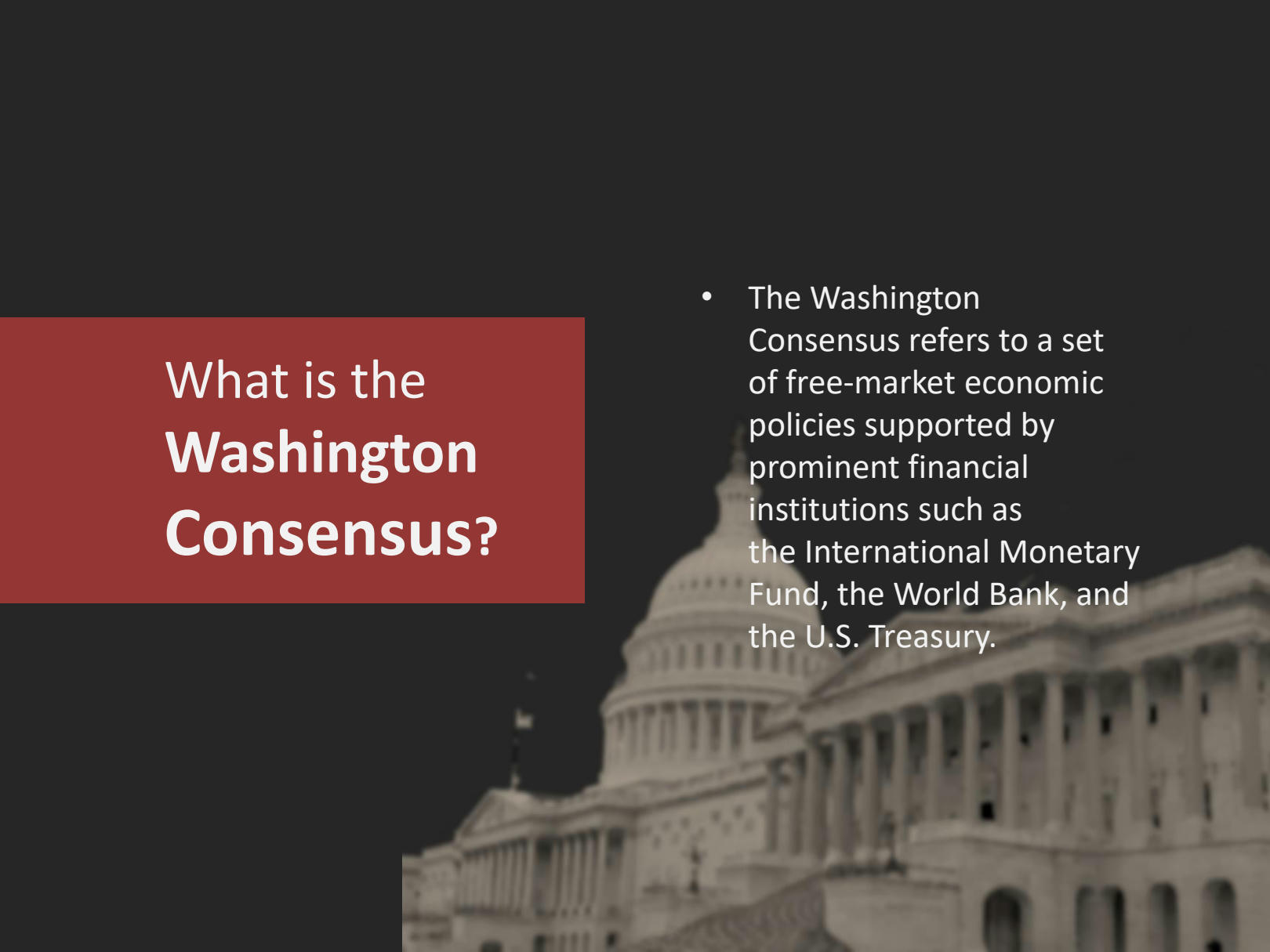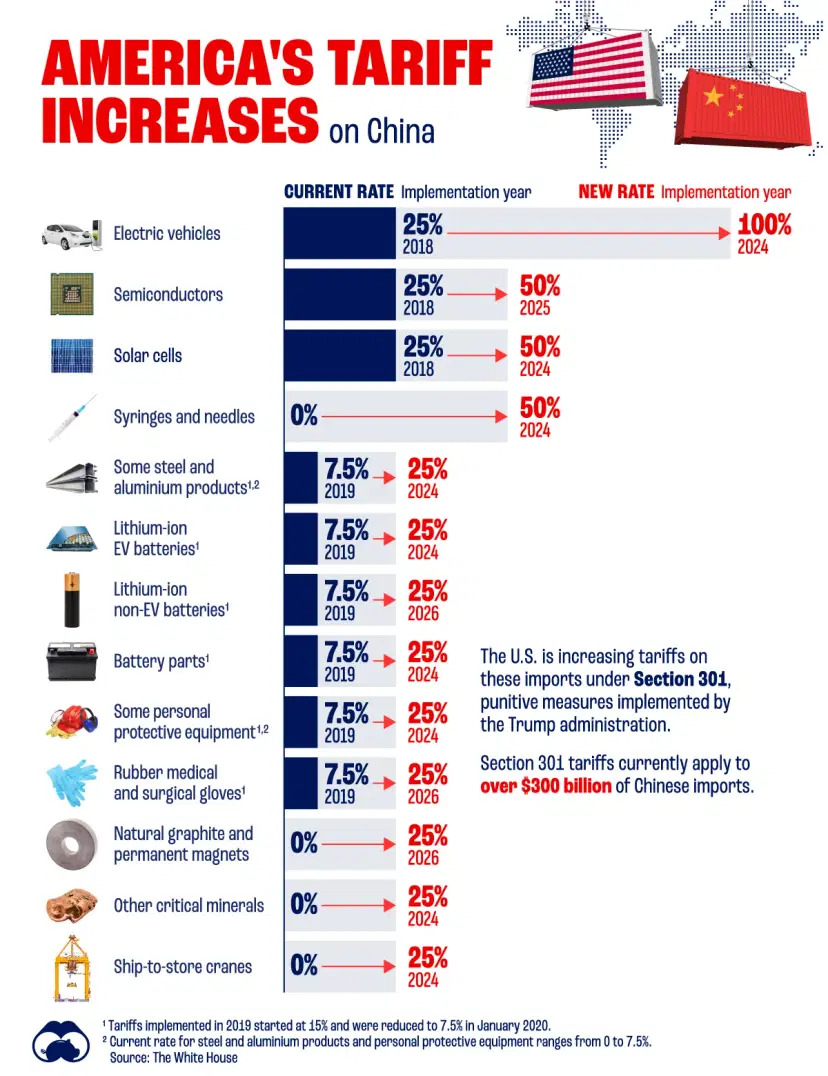
The Biden administration’s new China tariffs mark another milestone in the dismantling of the Washington Consensus, the neo-liberal economic model emphasizing free trade that’s been globally dominant since the 1980s. Among Washington policy-makers, tariffs are clearly back in vogue.
The significance of this round of tariffs is mainly symbolic and political. Their economic effect is for the most part negligible, though there is one exception: they will help shape the global future of Electric Vehicle (EV) manufacturing.
To begin, the tariffs target a mere $18 billion of annual imports from China, focusing on batteries, solar cells, chips, electric vehicles, steel and aluminum, medical goods, and critical minerals. That is a bit more than four percent of what the U.S. imports from China, and pales in comparison to the 300 billion in goods the Trump administration targeted with its tariffs.
The impacts will thus be felt by a limited number of industries and end-users. Chinese-made medical supplies like syringes and personal protective equipment are likely to increase in price for U.S. hospitals, but for the most part Americans don’t use large amounts of the targeted Chinese goods.
The EV sector, the most prominent focus of the new tariffs, is a case in point. Chinese made EVs will face a tariff rate of roughly 100%, quadruple the current level of 25%. However, the United States imports virtually no Chinese EVs. Only two models could face these tariffs, one of them a Volvo, a company with global production sites.
Consequently, the impact of the tariffs will be small for American consumers. It will also have little effect on American EV makers and users, for now. As the Biden Administration has made clear, the high tariff rate aims to forestall a potential flood of low-priced EVs from China in the future.
Tesla CEO Elon Musk remarked earlier in 2024 that Chinese EVs are by now so advanced and price efficient that without trade barriers, “they will pretty much demolish most other car companies in the world.” The tariffs are a preemptive move to protect American industry; less about crushing trade with China than heading off an anticipated flood of Chinese imports.

(Photo: Visual Capitalist)
Tariffs are generally frowned upon by economists. They exact high costs on consumers, act like a consumption tax, and benefit sheltered domestic producers, most of whom churn out goods of lower quality at a higher price. But the protection of “infant industries” – industries that are in the early stages of development – is widely recognized as a valid cause for levying tariffs.
There is therefore a rationale, one of industrial policy, to Biden’s trade policy. Tariffs are meant to foster a large and competitive clean energy supply chain in the United States. Or, put differently, American policy-makers have learnt their lesson from the 1980s when Japanese automakers entered the American market and cornered Detroit.
Nonetheless, for the most part the new Biden tariffs are pure politics. It’s an election year, after all. As Biden prefers to frame it, the tariffs are to protect American workers in strategic industries key to national security and future competitiveness. But more importantly, they’re intended to woo Trump voters in rust belt states, several of which will be critical to win the electoral college in November.
Trump himself has touted massive hikes, such as a 60% across-the-board tariff on all Chinese goods, if once more elected. The White House is stopping well short of this, arguing Trump’s hikes would fuel inflation and go too far in countering China. And for good reason. If implemented as announced, Trump’s trade policy could plunge the world into a 1930s style trade war with no winners.
Biden’s approach is clearly more measured, more strategic. A few of the original Trump tariffs have even been excluded, such as those on machinery used to make solar panel components. American makers of solar panels require the most advanced machines, which are now made in China. Current tariffs undermine the industrial policy goal of growing a clean-energy supply chain domestically.
This example, however, illustrates the major drawback of the Biden tariffs: industrial policy goals are being undermined by politics. If American policy-makers were serious about growing a clean energy supply chain, tariffs would apply to all countries of origin equally.
Singling out China puts geopolitical competition (and the domestic political appeal of such) above industrial policy aims. In fact, to grow a clean energy supply chain requires more than just exclusion. The Biden administration seems to understand this. It’s providing “carrots” to incentivize investment and innovation in various key sectors.
Although better than Trump’s “all stick, no carrot” approach, Biden’s lacks important policy planks. First, American consumers need to want to adopt new green technologies, especially EVs. Yet, trends are going in the opposite direction, despite relatively high gas prices. A national charging network for EVs and “range fear” remain problems. There have also been quality issues, especially with products from the market leader, Tesla. And the resale value of EVs is awful. Without buy-in from American consumers, any amount of industrial policy paired with tariffs will fall flat.
Second, U.S. industrial policy must not only seek to sustain technology leadership, but also play catch up. For instance, American producers are lagging in battery manufacturing technology, an area in which Chinese and Korean companies lead.
In this situation, it makes little sense to exclude Chinese firms based purely on their national origin. As happened in the gas-powered auto sector four decades ago, if the United States can successfully attract auto manufacturers to invest onshore, much manufacturing will take place domestically, creating jobs, a competitive environment, and rapid adaptation of global best practices and technologies.
The Biden tariffs will need to be paired with measures to make EV ownership in America palatable, if not preferable. Equally important, the very best EV manufacturers and their supply chain partners need to be incentivized to invest onshore in America. No one single country should be excluded. Otherwise, U.S. supply chains and their innovation will be disadvantaged.
